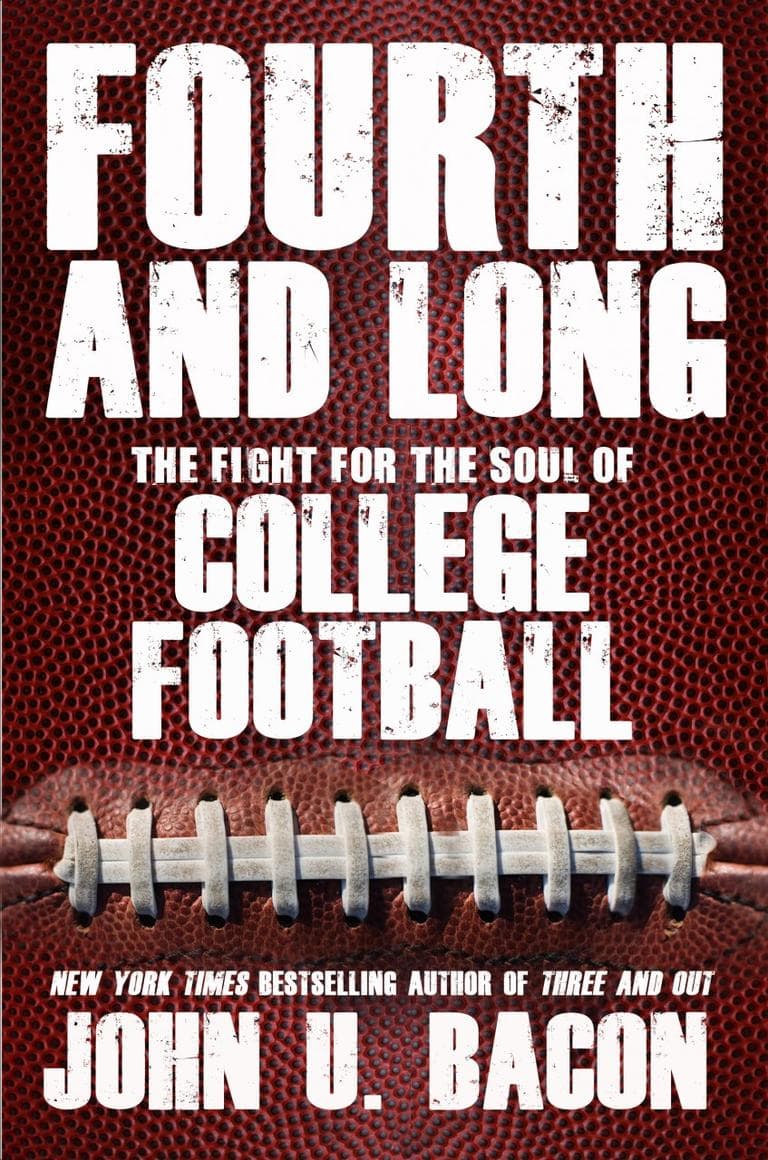Advertisement
An Excerpt From 'Fourth And Long'
This excerpt appears in the book Fourth and Long: The Fight for the Soul of College Football by John U. Bacon. The author spoke with Bill Littlefield on Only A Game. (Listen to our interview and read Bill's book review.)
If the Big Ten’s decision to add Nebraska created some unintended by-products inside the league, it was nothing compared to the chain reaction the small spark started outside the Midwest, throwing the nation’s biggest conferences into major upheaval—perhaps the biggest in the history of college sports.
After Nebraska bolted to the Big Ten, former Big 12 brothers Missouri and Texas A&M bolted to the SEC, and Colorado went to the Pac-10, along with Utah, making it the new Pac-12. Shortly thereafter, Syracuse and Pittsburgh announced they would be leaving the Big East to join the Atlantic Coast Conference.
Those changes aren’t as geographically twisted as seeing Marquette and DePaul—and even, for a little while, Texas Christian, Boise State, and San Diego State—join the Big East. Which raised the question: Just how big is the East, anyway? Big enough to swallow half the Midwest and chunks of Idaho, Texas, and California?
By the time the dust settled, all eleven major conferences had gained or lost at least one member.

In the aftermath, I was struck by how many people who don’t care too much about sports seemed to care a lot about this. For nonsports fans, college conferences are kind of like your parents as you get older. You might not check in with them every day, but it’s good to know they’re there, something you can count on in an uncertain world.
Nothing defined our nation’s regions better than our conferences used to.
What is the Midwest? Depending on who’s talking, it could span from western Pennsylvania to Montana, from North Dakota to Oklahoma. But when someone said “Big Ten Country,” you knew they meant the Great Lakes states. The Big Eight connected the Great Plains states—nearby, maybe, but night and day to those of us who live here. The Southeast Conference connected the Deep South and was fundamentally different from the Atlantic Coast Conference—which was exactly what it said it was. The Ivy League—well, that’s a label unto itself, while the Big East linked the biggest schools in the biggest cities in, yes, the East. It all made perfect sense. It fit.
These bonds were part of our very identity. Of course, each school’s students, alums, and fans think their conference is the best and can even give you specific reasons why it’s better than the one next door, but fans from all conferences felt a connection to the center, and it held. What these conference schools all had in common was sometimes hard to pin- point, but—to paraphrase Supreme Court justice Potter Stewart’s famous line about pornography—we knew it when we saw it. When the university presidents founded these conferences, they sought kindred spirits— and they were amazingly successful at finding them.
Somehow Iowa has more in common with Wisconsin than it does with Iowa State—and all parties seem to understand this intuitively, just as we all knew where to sit in the high school cafeteria. No one told us, but we knew where we belonged.
These conferences were so stable for so long, it was easy to identify with them. Schools bragged not just about their teams, but about their conferences, painting their league logos on their fields and their courts. If you wandered into a sports bar in any of those college towns, hanging overhead you would see the banners of every member of their league— and that meant the banners of their rivals, too. And no other sport has rivalries like college football has rivalries.
I have never attended Indiana or Wisconsin or Michigan State, but I’ve visited them many times. I can get around their beautiful campuses and talk knowledgeably to their alums in Chicago bars, where everyone seems to end up.
But suddenly, by the fall of 2012, the whole jigsaw puzzle had been tossed up in the air, and all for two reasons: greed, and fear—the fear that some other football team would make more money on its TV deal than you did on yours.
The frantic, thoughtless redrawing that followed was akin to the way the British carelessly carved up the Middle East in the 1920s, without knowing the difference between Sunnis, Shiites, and Kurds, with disastrous results we’re still living with to this day. This mindless game of musical chairs threatened many of the biggest reasons why millions of us prefer college sports to the pros: geography, affinity, stability, and identity. And it tore apart rivalries that go back to the birth of modern sport.
When the Wall Street Journal asked Bill Martin, Michigan’s former athletic director, about the state of the game, he said, “We’re chipping away at what makes college football unique.”
When I followed up with him, Martin added, “The last thing you want college to do is become a professional environment. The last thing. Don’t let the NFL be your model.
“Take the band. That’s one of the most unique appeals of college sports. There’s not a professional team in the country that wouldn’t love to have the quality of a college band playing—and for free! Let ’em play!” Martin couldn’t answer one question, however: How many more chips can college football take before we can no longer distinguish it from the pro game?
This program aired on September 6, 2013. The audio for this program is not available.